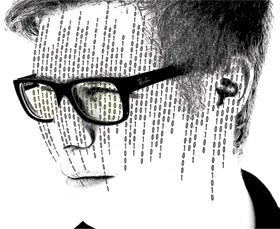

Surveillance within CCTV control rooms started off being very much of an open viewing, spontaneous, or unstructured process. Operators would view various monitors at their own discretion and if they saw something suspicious, they would follow up on it and view things in more depth. It led to some very good surveillance results, as well as some very poor delivery on systems.
Good operators picked up issues, while others would detect very little or nothing. In order to enhance the way people look at things, there are a number of developments that have occurred as far as CCTV is concerned to try and improve the strategy and the detection capacity of operators. In a sense, this is an attempt to professionalise viewing and enhance allocation of resources. This has led to a range of improvements that are coming out of control rooms.
However, with this structuring, are we killing natural or open surveillance and the benefits that came out of really good operators picking up things?
In the past, we have had operator success based on excellent situational awareness and the ability to visually analyse and detect more subtle signs of incident development. Training in surveillance skills and body language was one of the factors responsible for this success. However, equally, there are thousands of operators around the world who simply don’t realise what they are supposed to be looking for, and may be viewing with little appreciation of what they can pick up. The industry strategy to try and improve this situation has largely rested on the following initiatives:.
• Structuring viewing where operators are given designated time and tasks to view and report on specific areas/people.
• Implementing video analytics for assisted detection.
• Implementation of online occurrence books.
• Intelligence collection and entry.
Structured viewing
In order to deal with what is at times almost seen as random viewing, giving operators a specific focus and structuring their viewing activities is a way of directing the operators’ attention to particular things. It may be part of a process, a person, a particular area or site which would allow dedicated attention.
I’ve written previously about having something like virtual roadblocks, where an area is viewed and audited. Similarly, processes, people, procedures, transactions and social behaviour can all be reviewed and checked for adherence to regulations or deviations from expected behaviour. This in principle is a great idea to focus operator’s attention.
It also means though, that effectiveness is only going to be dependent on the supervisor’s or manager’s identification of the right things to be looking at. Poor choice of the structured surveillance target will simply mean closer attention and a lot of time given to something that doesn’t matter. In some cases, operators can also display a lack of comprehension of what constitutes a target. This can be aggravated by a lack of awareness of the environment or conditions being reviewed.
If surveillance operators are not trained sufficiently in what they should be looking for, and the signs of something wrong that they should be following up on, it doesn’t matter how much time they spend looking at the scene. There are also times when an operator may be tracking a suspect who has displayed indicators of intention to commit a crime, but then has to switch to a structured activity which is designated formally to be happening at a particular time. In this sense, structure can actively work against open surveillance flow and success.
Video analytics for assisted detection
Video analytics work most effectively in a simple situation where they can recognise presence, movement, or density of population. Detection of more subtle theft behaviour is usually well beyond them. While they can have a strong role to play in alerting operators to the existence of someone in an area as an alarm type condition, operators still need to identify the behaviours that show a crime incident is occurring. The potential for high rates of false alarms is still a significant drawback to some types of video analytics and they do not replace the operator function or skills.
Online occurrence books
Written occurrence books have typically not been a shining example of how best to collect incident information. They were often poorly recorded with little information and facts and a minimum of data, but this also meant that operators had to spend little time on them. Often occurrence books were not even looked at ever again after they were completed and put away.
Online occurrence books provide the opportunity to allow you to complete extensive data, make this an auditable process, allow a search for information and trends afterwards, and provide access at any time. Given this, many of the occurrence books have extensive fields that need to be completed after any incident or event.
In some cases, even minor events are fully recorded. However, this imposes a significant administrative overload for operators with time and details required for each event. This in turn takes away the time for live surveillance which is what people are expected to be doing.
On one site I visited, the CCTV operator had to record details in the occurrence book of all the fence alarms which were occurring frequently during the day. This was so it could be shown that the fence alarm had been responded to. Unfortunately, given the number of both normal and false alarms, it meant that he was doing virtually no surveillance of the camera views, but was completing largely irrelevant alarm information all day. While extreme, this is clearly a supervisor or management problem that can occur in other areas as well and comes back to the effective management of time and resources.
Intelligence collection and entry
I’ve made a strong push for intelligence led surveillance for some years. It is an area that is being taken increasingly seriously as people put software systems into CCTV control rooms that allow improved analysis of risks and provide a basis for the more strategic use of CCTV resources. However, data collection for intelligence systems is an intensive process and requires a lot of time.
The administrative process of populating the data on these systems often falls to operators. It also serves to draw them away from the surveillance tasks. Increasingly, there is a need for a specialised person to collect and interpret such intelligence information. While potentially a really useful tool, intelligence needs to be integrated into the control room environment so it complements the surveillance function rather than reducing it.
I think these steps to create a more organised and structured viewing environment within CCTV control rooms are an essential step in creating more professional operations. However, one needs to be mindful of the impact of these and the need to manage them effectively so they provide a constructive benefit to the surveillance function.
As in many instances, this is a clear supervisor and management responsibility. For me, the use of open surveillance by skilled operators also still provides an extremely useful role in protection and detection. It is in this unstructured viewing that some personnel are able to get more of a feel and situational awareness, pick up the subtle signs and nuances that show something is happening, and successfully detect incidents out of the ordinary or conventional risk frameworks.
No matter how you structure the control room surveillance process, I’d recommend free open viewing periods on a regular basis where operators can show just how good they are at detection. This shouldn’t be a rest period, but one where operators are expected to deliver detection results on their own viewing approach, to show just how good they are.

Dr Craig Donald is a human factors specialist in security and CCTV. He is a director of Leaderware which provides instruments for the selection of CCTV operators, X-ray screeners and other security personnel in major operations around the world. He also runs CCTV Surveillance Skills and Body Language, and Advanced Surveillance Body Language courses for CCTV operators, supervisors and managers internationally, and consults on CCTV management. He can be contacted on +27 (0)11 787 7811 or craig.donald@leaderware.com
| Email: | sales@leaderware.com |
| www: | www.leaderware.com |
| Articles: | More information and articles about Leaderware |

© Technews Publishing (Pty) Ltd. | All Rights Reserved.